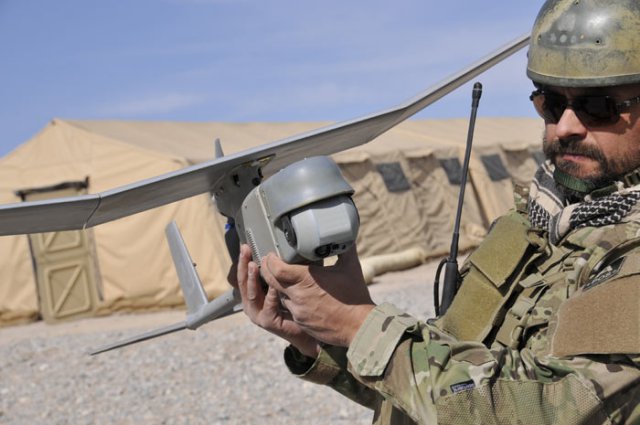Unmanned aircraft systems are becoming so important to military operations that the Marine Corps is adding UAS training to its basic curriculum for new officers.
The Raven will soon be a common name to every Marine who has completed The Basic School (TBS) officer course. Thirteen TBS instructors finished a two-week course May 22, where they learned how to operate, maintain and integrate the RQ-11B Raven small unmanned aircraft system (UAS) into their upcoming basic school curriculum. The course, held at Marine Corps Base, Quantico, Virginia, was led by a team from the Navy and Marine Corps Small Tactical Unmanned Aircraft Systems (PMA-263) Training and Logistics Support Activity (TALSA).
Maj. Justin Betz, TBS air officer, anticipates integrating Raven UAS instruction into the basic officer courses beginning later this year. The current TBS curriculum does not include small UAS training or instruction.
“By teaching and training this at the first school new Marine officers attend, they will take this knowledge and develop new tactics, techniques and procedures earlier on in their careers, helping the Group 1 UAS program grow within the Marine Corps,” Betz said.
The Raven, RQ-12A Wasp and RQ-20A Puma make up PMA-263’s Group 1 portfolio, which are categorised as unmanned aircraft weighing less than 20 pounds. They can be hand-launched and provide intelligence, surveillance, reconnaissance (ISR) and target acquisition to the warfighter on the ground.
Major Peter Fukushima, Warfighting Marine Air-Ground Task Force (MAGTF) section head who will be overseeing the use of Group 1 training at TBS, said classroom instruction will be incorporated into the aviation courses that are already provided and then phase in field exercises using the cadre of 13 instructors to operate the systems. The curriculum will train Marine officers to utilise the capabilities that Group 1 UAS bring to the task force and incorporate that into their mission planning and considerations.
“We are taking TBS training to the next level through the use of unmanned ISR and encouraging student officers to include some basic aviation considerations into their mission planning,” Fukushima said. “Through early exposure to a variety of aviation assets at TBS, the idea is to foster greater air-ground integration and enable students to be successful in the future.”

The Marine Corps currently uses small UAS, but they are not a widely known resource at this point. Betz said with their main focus being Expeditionary Force 21 – a recently released 10-year road map emphasising the mobile nature of the Marine Corps – Marines will need light weight, back-packable, multi-mission small UAS to meet the challenges associated with operating in small units with limited lift and transportation equipment.
“The advantage of Group 1 UAS is that they are lightweight and easily transported by Marines in small units while on foot or mobile patrols,” Betz said. “Instead of relying on the Marine Air Wings, which have traditionally provided ISR with larger-sized UAS, units can have in-house trained Marines that are mobile and still have the ability for airborne ISR.”
He said they hope to integrate the Puma and Wasp into future curriculum.
“PMA-263 has been supporting the Marine Corps with Group 1 systems since 2006, but until now it was small divisions and specials operations,” said Col. Eldon Metzger, PMA-263 program manager. “Now that TBS instructors are certified Raven operators, they will be influencing every
Marine officer and the future of small UAS operations in the field and ultimately the expeditionary nature of the mission.”
With small unmanned aircraft systems becoming a vital aspect in the ever-changing battlefield, PMA-263’s Group 1 systems and TALSA sites provide consistent training and support to the fleet. TALSA-West, located at Twentynine Palms, California, opened its doors June 2013 as the second training facility of its kind in the country. Already they have trained more than 200 students. TALSA-East, located at Camp Lejeune, North Carolina, opened July 2012 and has trained over 300 Sailors and Marines.
Photo: Albert Edge, centre, Training and Logistics Support Activity (TALSA) instructor with Navy and Marine Corps Small Tactical Unmanned Aircraft Systems (PMA-263) demonstrates the RQ-11B Raven small UAS ground control station to Marine Corps officer school instructors who were completing a two-week Raven operator certification course at Marine Corps Base, Quantico, Va. in May. – U.S. Navy
Source: Navair News

